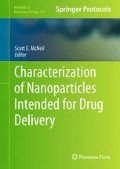Abstract
Hemolysis is damage to red blood cells (RBCs), which results in the release of the iron-containing protein hemoglobin into plasma. Here we describe an in vitro assay specifically developed for the analysis of nanoparticle hemolytic properties (see Fig. 1). In this assay, analyte nanoparticles are incubated in blood, and hemoglobin is released by damaged cells and converted to red-colored cyanmethemoglobin by reagents. The nanoparticles and undamaged RBCs are then removed by centrifugation, and the amount of cyanmethemoglobin in the supernatant is measured by spectrophotometry. This measured absorbance is compared to a standard curve to determine the concentration of hemoglobin in the supernatant. This hemoglobin concentration is then compared to that in the supernatant of a blood sample treated with a negative control to obtain the percentage of nanoparticle-induced hemolysis.

Schematic illustration of the steps in this in vitro assay to evaluate nanoparticle hemolytic properties. PFH is plasma-free hemoglobin. CMH is cyanmethemoglobin. TBH is total blood hemoglobin.
Access this chapter
Tax calculation will be finalised at checkout
Purchases are for personal use only
References
ASTM standard practice F 756-00. Assessment of hemolytic properties of materials.
DeSilva, B., Smith, W., Weiner, R., Kelley, M., Smolec, J., Lee, B., Khan, M., Tacey, R., Hill, H., and Celniker, A. (2003) Recommendations for the bioanalytical method validation of ligand-binding assays to support pharmacokinetic assessments of macromolecules. Pharm Res. 11, 1885–900.
Bioanalytical method validation. Guidance for industry. FDA/CDER/CVM. May 2001. BP.
Acknowledgments
This project has been funded in whole or in part with federal funds from the National Cancer Institute, National Institutes of Health, under contract N01-CO-12400. The content of this publication does not necessarily reflect the views or policies of the Department of Health and Human Services, nor does mention of trade names, commercial products, or organizations imply endorsement by the US Government.
Author information
Authors and Affiliations
Corresponding author
Editor information
Editors and Affiliations
Rights and permissions
Copyright information
© 2011 Springer Science+Business Media, LLC
About this protocol
Cite this protocol
Neun, B.W., Dobrovolskaia, M.A. (2011). Method for Analysis of Nanoparticle Hemolytic Properties In Vitro. In: McNeil, S. (eds) Characterization of Nanoparticles Intended for Drug Delivery. Methods in Molecular Biology, vol 697. Humana Press. https://doi.org/10.1007/978-1-60327-198-1_23
Download citation
DOI: https://doi.org/10.1007/978-1-60327-198-1_23
Published:
Publisher Name: Humana Press
Print ISBN: 978-1-60327-197-4
Online ISBN: 978-1-60327-198-1
eBook Packages: Springer Protocols

